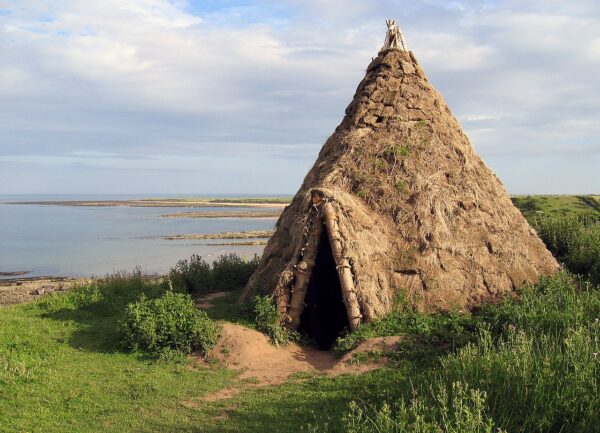 So far we have talked about the Mesolithic in quite general terms and not discussed any Lincolnshire sites in detail. This is because our knowledge of the Mesolithic tends to be nationwide inferences based on a small number of actual sites that are spread out across the whole of Britain.
So far we have talked about the Mesolithic in quite general terms and not discussed any Lincolnshire sites in detail. This is because our knowledge of the Mesolithic tends to be nationwide inferences based on a small number of actual sites that are spread out across the whole of Britain.
This is particularly true of settlement sites, of which very few are known and even less have been subject to controlled excavation. Which is a shame, because Mesolithic settlements are fascinating. The two best examples of settlements are from North of Lincolnshire and both are found on the North Sea coast. These are Star Carr in North Yorkshire (just south of Scarborough) and Howick House in Northumberland (northeast of Alnwick). In both of these sites, structures have been found that are formed on a circle of postholes around a circular depression. These are similar to the remains of more recent Native American structures (thousands of years more recent) and that has led to a general interpretation of a conical circular shelter covered with a waterproof material such as hide, reeds or turf. Around these structures are found evidence of everyday life in the form of flints and flint knapping debris. Fireplaces have been found both within structures and in the area close by. One thing that is clear is that these sites are occupied for some considerable time, possibly in excess of one hundred years. Hardly the transient camp of constantly moving hunter-gatherers. They strongly suggest that there was a permanence to Mesolithic life which we seldom imagine.
But where are the settlement sites in Lincolnshire?
A lack of sites is often taken as evidence of a lack of inhabitants, but this should not be taken as absolute. There is no reason why the Lincolnshire landscape would be any less appealing to our Mesolithic ancestors than Yorkshire, Northumberland or any other part of the country. In fact, many of the aspects of the Lincolnshire landscape that are cited as reasons not to settle in later periods (marshy coastlines, wet river valleys etc…) are actually more attractive to hunter-gatherers than open heath or even dense woodland.
So why aren’t we finding the settlements? One reason is that wetlands accumulate layers of sediment over time. A Bronze Age site in the Fens can be four or five metres deep below layers of silt and clay. A Mesolithic site could be even deeper. When the people of the Mesolithic inhabited Lincolnshire, sea levels were much lower, in the millennia that have followed sea levels have risen and deposited layer upon layer of silt, sand and clay over the remains of ancient settlements.
This in turn makes it less likely for settlement sites to be found in Lincolnshire. Many years ago, when I was a student, Dr Jones (not that one) would explain to us the limitations of archaeological evidence so that we would be better at interpreting what was found. One of his favourite sayings was “maps show the distribution of archaeologists, not archaeology.” What he meant was that there is archaeology everywhere, but only certain modern circumstances result in it being discovered and investigated. Most activities that disturb the ground will only affect the first metre or so of a particular place. This is deep enough to reveal more recent sites from the Iron Age onwards, but the much earlier sites could be located in these same places, but deeply buried and undisturbed by modern development. It is only when major activity such as gravel extraction, or road and railway building take place that the more ancient remains are likely to be exposed and have the possibility of being identified. Lincolnshire’s society and economy are such that major engineering works of this kind are few and far between.
If that didn’t make life difficult for the archaeologist there are also problems caused by the fact that fragile settlement indicators (bone needles for example would be made and used close to where people live) do not survive well in the ground for thousands of years. Then there is the sheer enormity of the task. Lincolnshire is a very big county and Mesolithic settlements can be just a few metres across. To hit upon one by luck alone is a pretty tall order.
But I want to end on a positive note. The settlements are there, waiting to be found, and it is you, dear reader, that can help us find them. Every time a member of the public reports finding a piece of shaped flint or worked bone, there is a chance that this is a miraculous survivor from the Mesolithic. If it is reported accurately and the location noted, it can be used as a part of an overall pattern of evidence that will eventually lead us to the Mesolithic houses of Lincolnshire.
We may be looking for a bone needle in a giant haystack, but you can help.
